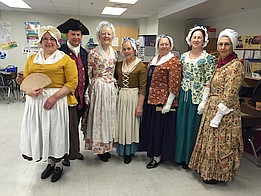Shift
Main undergarment worn under stays. It is made of linen or muslin. It has three-quarter length sleeves, with underarm gussets.
Stays
Are for any event in public. Stays are worn regardless of station in life. Stays are the 18th century version of a boned corset. They sometimes have shoulder straps, sometimes not. They have a distinctive shape which molds the body differently from the 19th century corset. They have tabbed hems at the bottom which fit over the hips.
Jumps
This vest-like garment is worn by some women as an outer garment; however, it is not documented historically accurate for outer wear. It is generally accepted that these are undergarments, and worn under a jacket or short gown. They should be cut long in length to fit over the hips with the petticoat coming over the top of the lower portion of the jumps. They provide support when needed without the rigidity of stays.
Petticoat
Today, we know petticoats as skirts. Women wore them in multiples, one serving the purpose of a slip, the other one serving as an outer garment.
Bed Jacket or Short Gown
These loose jackets are held together with pins or by tying the apron around the waist. There are no buttons or hook and eye closures. The bed jacket is not something worn to bed or to lounge, but rather an outer garment often seen in illustrations and paintings. It’s mid-thigh in length. The short gown is also open down the front with no closures, but is shorter than the bed jacket. The jackets have sleeves; however they are not always long sleeves. The sleeves were sometimes removable and taken off for working in hot weather. Both types of jackets are cut in the shape of a “T” and in one piece, if possible, and stitched down each side. The sleeves can be pieced, and in fact, many originals survive which have been pieced in ingenious ways in order to have enough fabric to make the garment
Neck Handkerchief
They should always be worn at a daytime activity regardless of station. At night it would be the choice of the interpreter. These are approximately 30-34 inch square and worn about the neck. They later evolved into the fichu of the 19th century. They may be triangle shaped, or square folded corner to corner. They can be made of cotton or linen for summer, and heavier fabric or wool for winter. They can be worn tied, pinned or tucked into the front of a bodice. They were not always white, could be made of silk or even dyed. They were also of checkered fabric.
Apron
Eighteenth century aprons are not nearly as full as those of the 19th century. Since few women wear 19th century aprons full enough perhaps some could be recycled. They have narrow cotton tape for ties which were worn wrapped around the back, back to the front and are tied in front. They can be made with the pinner, which you can wear with or without it, so that you only need to make one.
Cap
Most women wore caps. Peter Kalm wrote, “All women in the country without exception wear caps of some kind or other.” Most caps are made of fine cotton or linen, and are white. They’re for all daytime wear with hair well secured beneath it. It is not necessary to hide all hair but it should appear to be long and pulled back. Ladies had short hair only if they had to cut it to have a new wig made, if they had been ill, or if they sold it for money. They would still want to look as if it were long. The only time an interpreter might have some loose hairs fly away from under a cap is if the person is interpreting a cook and is actually cooking something over an open fire. If that same cook were shopping for her supplies she would be dressed for shopping. There are any numbers of methods for controlling short or flyaway hair. The circular, gathered “mob” cap is not correct. Please see the above books for photos and illustrations of period correct caps. In place of a cap, a woman working outdoors might wear a kerchief on her head.
Enhancements
If you’re new and you make servant/lower sort clothing, the only added item you might need would be a pocket or apron. For any open gown or jacket that is designed to have pocket hoops or some sort of rump roll, they should be worn with those enhancements.
Hair and Make-Up
During the day, hair is under a cap. In the evening, it might be dressed, and if it’s short, it’s hidden under a wig which might also be dressed. If you’re a servant/lower sort with short hair, wear a cap. Lower sorts do not wear make-up during the day and wear very little in the evening. Make-up on other classes should be appropriate to the class and the period; for example, bright pink glossy lipstick would not have been around in the 18th century. Never, never wear nail polish unless you plan to keep gloves on the entire time. That might work at a ball, but during the day, mitts were more appropriate and nail polish would be seen.
Footwear
Twenty-first century shoes may be worn only if they can be altered to look similar to those of the 18th century. If you are a servant/lower sort, flat clogs with the appropriate toe/front are easy enough to find and not expensive. Working women may go barefoot, weather permitting, or wear an appropriate documented style of moccasin, especially if your impression is Native American or Celtic. Eighteenth century shoes had a distinctive shape and heel so ask, and do your homework before investing in a pair.

